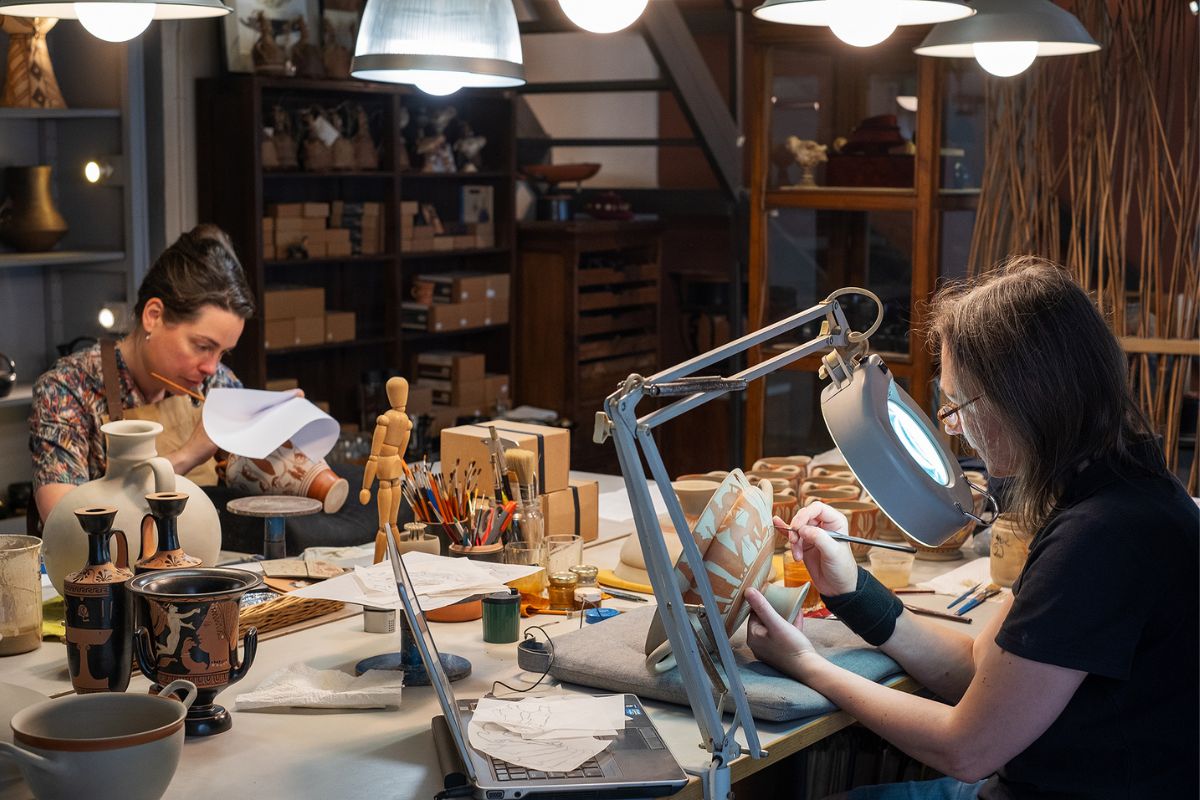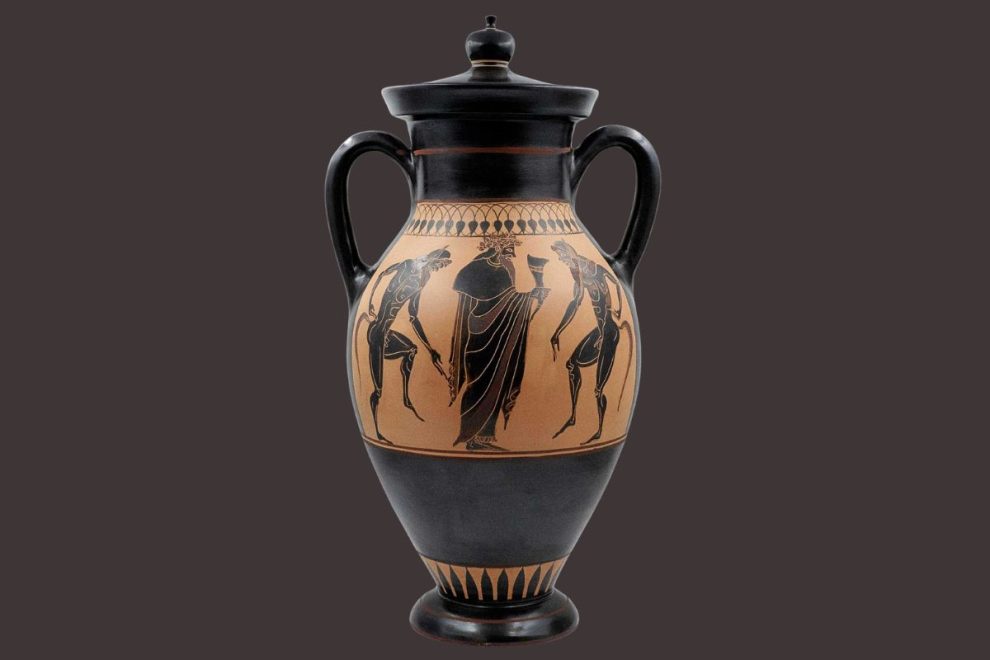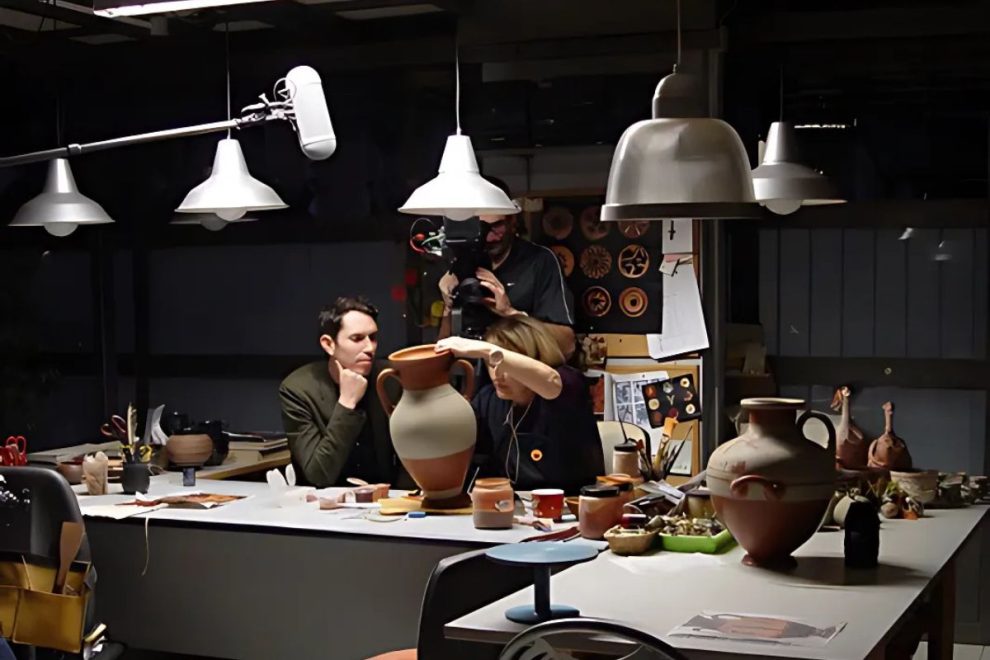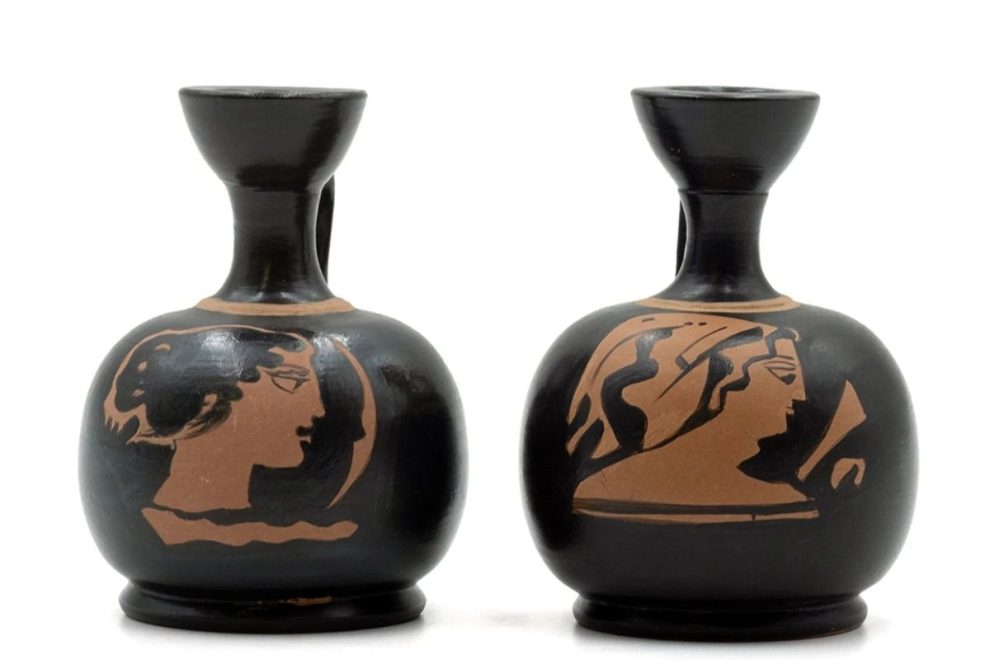
This blog explores the significance, function, and artistry behind ancient Greek vase shapes.
Key Highlights
- Ancient Greek vase shapes were integral to ancient Greece, showcasing artistic ingenuity and craftsmanship.
- The diverse forms such as amphoras, kraters, and kylixes served practical and ceremonial purposes in daily life and Greek rituals.
- Vase painting emerged as a significant art form, depicting symbolism and scenes from the ancient world and Greek literature.
- Amphoras were used as storage vessels, particularly for olive oil, while kraters played a key role in wine mixing at symposia.
- The evolution of vase forms from Minoan pottery to the Hellenistic period reflects the history of Greek art.
Transitioning into the details, let’s explore the fascinating history and symbolism of ancient Greek vases.
Ancient Greek art is not full without looking at the role of vase forms. These vases were a key part of the pottery of ancient Greece. Their shapes and looks were not just made for use, but they also showed the style, life, and tastes of the people back then. From Minoan pottery at the start to pieces made in the Hellenistic period, each vase helped keep well-known ancient Greek vase shapes and Greek art alive over the years. These vases from ancient Greece let people see the way art changed with time. This guide shows the value, types, and deep beauty that turn these vases into pieces from the ancient world that many still love and study now.

The Significance of Ancient Greek Vase Shapes in Ancient Greek Culture
Vase shapes were very important in ancient Greek culture. People in ancient Greece made vases to use every day, but they also made them look beautiful. Many Greek artisans spent a lot of time and energy designing ancient Greek vase shapes that showed what life was like in ancient Greece. These vases were not just for daily use. They meant something deeper for the people. Vases took part in important moments like ceremonies, parties, and even funerals. Every vase shape and picture said something about their values, what they believed, and how they saw their world. Greek art on these vases helps us understand the old traditions, ideas, and ways of life in Greece. This is why vases are such a key part when people study ancient Greek and Greek art.
Uses and Functions of Greek Vases
Greek vases played an important role in the daily life of people in ancient Greece. The uses of these vases were many, and they were found in almost every part of Greek society. They were often used as containers for olive oil, which was very important in ancient Greece. These vases were shaped in ways that made them strong and easy to use for storing and moving things from one place to another.
Funerary urns and grave goods were a big part of rituals for people who had died. Large vases, like the lekythos, were placed in tombs to help remember and honor someone after they had died. Smaller vases held things like perfumes or oils, and these were used a lot in daily grooming and getting ready. Jug-shaped vases, called oinochoe, were used to pour and serve wine during get-togethers. Pottery in ancient Greece looked good and had many uses at the same time. People in Greece respected their vases because they worked well and looked nice, showing how much, they valued good design and everyday items.
Symbolism and Artistic Expression
Vase painting on Greek pottery was not just about decoration. It had deep meaning from the ancient world. Artists used scenes to show ideas from Greek literature and daily life. The vases often had stories about myths, daily work, and old rituals. These painted pictures gave people a way to see what was important in that time. Symbolic images on the vases told stories or shared beliefs of the people. Sometimes, kylixes, which are drinking cups, surprised the user. As you drank wine, you would see painted images appear at the bottom, making the pottery more fun and cleverer.
Greek potters wanted to both tell stories and be creative with their vase painting. The detailed designs and shapes of these vases showed how skilled the potters and artists were. They got ideas from the world around them, from things in nature, and from mythology. When you put together the symbolism, the new ideas, and the ways of the ancient world, you get more than a plain object. The vase became more meaningful, showing what people valued then, and turning pottery into lasting pieces of art.

Ancient Greek Vase Shapes
The ancient world had many ancient Greek vase shapes. Each vase had its own look and use. Some common types were amphoras, kraters, hydrias, kylixes, and pyxides. There were other shapes too. You could see both standard and significant designs. These shapes changed over time. People used the vases for many things. Some used them for daily work, some for decoration, and some for their meaning. A few vase shapes came from old silver vessels. This shows how other styles in the ancient world affected Greek art. Names like amphora and kylix are now famous when people talk about ancient Greek art.
Amphora
The amphora is one of the best-known vase shapes from ancient Greece. It goes back to a time before 500 BCE. People made and used this vase mostly to store things, like olive oil and other items that were important for everyday life and trade in Greece. Attic amphoras were valuable because people put a lot of effort into their designs and writing on them. Besides looking nice, they had a long neck to help you pour things out and a wide body so you could fill it with more.
People would even put these amphoras in graves as grave goods. This showed the person had high value and was respected in society. There was a style called the Nolan amphora, too. It had a longer neck and people used it more often in fancy places. Today, people look at these amphoras and see more than just practical things from ancient Greece. They are also reminders of the high skill in craftsmanship from that time.
Pyxis
The pyxis was a small box made from terracotta. People often used it to keep perfumes or other small valuable things safe. The idea of the pyxis first came from Minoan pottery. Soon, it started to be seen in ancient Greek art as one of the grave goods placed next to a person in funerals. The shape of the pyxis was usually round like a cylinder. Many potters took care to put fine designs and patterns on it. These small containers had symbolic value in ancient Greek life, as they showed something about both vanity and tradition.
While some were tiny, they showed a lot of style and detail in the way they were made and decorated. The ancient Greek pyxides show us how Greek artists could take something useful in daily life and fill it with artistic stories and meaning. This mix of using common pottery for beauty and storytelling left an impact on ancient Greek art, which lasted for many years in Greek culture.
Krater
Krater vases played a key role at Greek gatherings called symposia. They were made to mix wine with water. This mixing showed that people in ancient Greece cared about not drinking too much. The krater helped people follow their values about being careful with wine. These vases were big and had wide mouths. Their shapes and styles stood out, like the bell krater and the column krater. Potters from Corinth in Greece worked hard to make krater vases. They gave these vases looks that were cherished and fit well at big events. Greek kraters were more than for serving drinks. Potters often painted stories, scenes from daily life, and tales from old myths on them. These designs helped the krater vases show more than use. They became art and told us about life and ideas in ancient Greece.
Kylix
The kylix was a popular cup used for drinking in the ancient world. It had a wide top and two handles, which made it easy to hold. People used these cups at symposia, as well as in their everyday life. Attic potters often decorated a kylix with pictures. These paintings were about Greek myths or could even be funny stories. There was also a painted design, called a tondo, at the bottom inside the vase. When a person finished their wine, this design gave a surprise. This showed the clever and creative ways Greek potters made their work. The kylix is a good example of how people in the ancient world put meaning and art into simple objects. It shows the pride Greek potters had in what they made.
Kantharos
Famous for its tall, curved handles, the kantharos was a common drinking cup in ancient Greek art. People in ancient Greece saw it as a sign of life and new beginnings. This cup was also used a lot in Dionysian gatherings and celebrations. Potters often made kantharoi from clay. Now and then, some were made from metal for ceremonies. The high handles gave the kantharos a bold look. This made it easy to see the difference between this cup and other types of drinking cups in ancient Greek art.
The beautiful patterns on kantharoi showed the skill of the makers and the meaning behind the artwork. These cups were a big part of how people lived in ancient Athens and other places. The kantharos shows how something could be used in daily life and still be a work of art. This mix of use and design is a big part of ancient Greek and Greek art made by potters in those days.

Lekythos
The narrow-bodied lekythos was most often used in ancient Greece as a funerary urn. People put these pottery pieces beside graves as grave goods. The lekythos usually held olive oil, which people used for anointing and when they mourned someone, giving it spiritual meaning. Pottery of ancient Greece tells us many stories. Scenes painted onto lekythoi showed what life looked like in their time, along with moments of loss. These images helped keep the memory of the person alive. Over time, the form of the lekythos changed. There were new types like the acorn lekythos and thicker squat shapes. These changes showed creative ideas in pottery, but the meaning and purpose of these items in Greece stayed the same. They still held an important role in rituals and symbolized respect for the dead.
Hydria
The hydria was a very useful water jar in ancient Greece. It had three handles. People could use two handles to carry it and one handle to pour water. This smart design showed that ancient Greek people thought about how to make things easy to use. Attic hydrias were often beautiful. Greek potters liked to decorate them with detailed patterns. These hydrias were not just for the home. People also used them at public fountains and during spring events. You can often see these jars in vase paintings from ancient Greece. They showed how something could be both useful and nice to look at. The hydria stands as a strong sign of what ancient Greek people made and did. It also reminds us of the skill and creativity of Greek potters in Greece long ago.
Alabastron
The alabastron was a small vessel used mainly to keep perfumes and oils. It had a slim shape that made it simple to hold and use. This made it good for personal care and for taking part in different rituals. Minoan pottery was important in how people first made the alabastron. Later, Corinthian artists made these vessels more appealing to look at. The shapes and painted designs on each alabastron showed both skill and beauty. It was not only a useful item but also had artistic value. Even though the alabastron was small, it was easy to see its beauty in daily tasks and rituals.
Oinochoe
The oinochoe is a Greek jug used for pouring wine. This vase shows how the Greeks brought together art and daily use. You can see it a lot at drinking parties, called symposia. The curved spout on this jug makes it easy to pour wine in a smooth way. Early oinochoes came out in the Hellenistic period. These vases had nice shapes and the people made them with a lot of care. You could see detailed pictures on them. In Corinth, makers gave their jugs certain looks, so they became known for that style. That is one reason why these jugs got so popular. This Greek vase was important at social times and at events. People used the oinochoe as a way to show coming together as one group in their lives and in Greek tradition.
Kyathos
Looking like a small ladle, the kyathos was a cup used in the ancient world to move wine or other drinks during get-togethers. It had one handle, which made it easy to use, and it gave a nice touch to the old rituals people had back then. Some pottery kyathoi were made to look like metal vessels. These kyathos cups were crafted with care, so they looked good and worked well. People liked to use them at symposia, a time when people came together to enjoy drinks and talk. This showed how the ancient world loved to bring new ideas to how they drank and served wine. Kyathos designs also show the skill of Greek workers who made pottery. They found a way to join simple items with new art and the culture of their time.
Skyphos
A skyphos is a kind of drinking cup. It has a deep bowl with two handles on the side. People in ancient Greece used it to enjoy their drinks slowly. The shape of this vase changed over time as Greek potters tried new styles. This skyphos was mostly used for wine. But it was also seen in many social events where people gathered. In ancient Greece, artists often decorated the skyphos using vase painting. The designs showed different scenes of life and art. The skyphos is more than just a vase. It is a sign of Greek art and skill. People in the ancient world used this vase in their daily lives and in ceremonies. This simple object gives us a window into both art and life in Greece.
Phiale
A kind of dish used by ancient Greek people is the phiale. It is a shallow plate that was often used in their ceremonies. Most of the time, people made it from terracotta or metal. The phiale did not have much decoration, and this shows that people made it for practical use, primarily for religious offerings. This vase came from the Minoan pottery traditions. Over different Greek periods, including the Hellenistic period, the phiale changed and took on new styles. In Greek art, the phiale had an important place. People used it to pour drinks to the gods, called libations, and to hold perfumes. This made the phiale esteemed both in homes and at events with religious meaning. It is also a useful example when people talk about old Greek vase shapes or pottery today.

Key Features of Greek Vase Design
Greek vase design brings together use and beauty in a remarkable way. The vases often have clear shapes and very detailed art. Some common types you may see are amphora, krater, and kylix. Each one was made for something different, like holding olive oil or serving wine. The location of decoration on a vase usually matches what the vase was made to do. The artistic touches on each vase share cultural ideas from ancient Greece. Potters in Greece used black-figure and red-figure painting. These styles grew and changed over time, showing the continuous evolution of Greek art. All of these things together help us see how important these vases were in ancient Greece.
Anatomy of a Typical Greek Vase
When you look at the parts of a common Greek vase, you can see some distinctive features that show what it was used for. The main part is called the belly. The belly is the large middle section of the vase. Then, the shape gets smaller as it goes up to the neck. The neck holds the lip where you pour or drink. On the outside of these vases, you can find many types of decorative details.
These decorations teach us a lot about Greek art and the stories people told in ancient Greece. It is clear these vases were not just for show. They had big meaning in daily life and in religious events found in Greece and ancient Greek times. So, learning about how each vase looks and the art on it helps us know more about Greek vases and why they were so important in both the home and rituals in ancient Greece.
Decorative Techniques and Motifs
The art of making vases in ancient Greek times used many ways to decorate. Artists used designs that show what was important in Greek art and tell stories about Greek people and their ways of life. The most known methods are black-figure and red-figure painting. These styles show very fine details from tales about gods or things people did each day.
Some common patterns are meanders, palmettes, and shapes of animals. These add to the look of the vase forms. Every detail made in a vase had a reason. Some designs helped the vase be used well, and some just made it nice to look at. Many vases were used for things like holding wine or olive oil. Some were made to be kept as grave goods, buried with someone after they died. This tells us a lot about the long history of ancient Greek art and how it changed over time.
Evolution of Ancient Greek Vase Shapes Through Periods
Ancient Greek vase shapes changed a lot over time. This started with Minoan pottery and grew into the detailed styles seen in the Hellenistic period. Some vase forms were made for daily use, like storing olive oil. Others, like fancy kraters, were used at parties and gatherings. You can also see regional differences, with vases from Athens and Corinth having their own look. The continuous evolution of Greek vase shapes shows how art, daily needs, and life in ancient Greece were all linked together.
Regional Variations in Ancient Greek Vase Shapes
There are many different Greek vase shapes from ancient Greece. These changes come from the way local potters worked in each area. You can see this when you look at the Attic style, which is famous for being very neat and for having detailed pictures. This is not the same as Corinthian vases, which had many small animal pictures on them. In some places, like Eastern Greece, people started using new ideas and shapes. This led to types of vase art, like the hydria and the amphora. The Greek pottery kept changing over time. So, the types of vases you find show how the land and places shaped the vase styles in ancient Greek art. This made ancient Greece have a many-sided story when it comes to Greek vases and pottery.
The lasting importance of ancient Greek vase shapes shows not just the style people liked but also tells us a lot about how they lived. These vases had different shapes and detailed designs. They were useful for many things, and at the same time, they showed what people valued in society. From amphorae to kylixes, each vase type shows the skills and daily life of that era. The continuous evolution of these Greek vase shapes is part of what makes ancient Greek art and the story of the ancient world so exceptional. These pieces of Greek art still help us understand the past.
